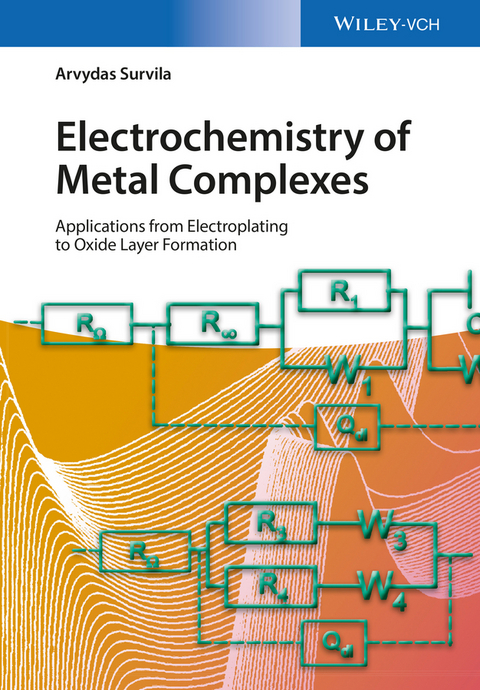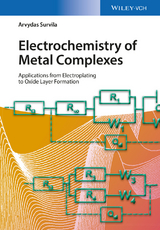Electrochemistry of Metal Complexes
Wiley-VCH (Verlag)
978-3-527-33877-1 (ISBN)
- Titel ist leider vergriffen;
keine Neuauflage - Artikel merken
Arvydas Survila is head researcher at the Center for Physical Sciences and Technology in Vilnius, Lithuania. Having obtained his academic degrees from Moscow State University, he spent most of his career working as professor at Vilnius University and Vytautas Magnus University (Kaunas). Simultaneously, he was the Head of Department of Electrochemical Kinetics at the Institute of Chemistry (Vilnius). Professor Survila has authored about 300 scientific publications. He obtained the prestigious Lithuanian Scientific Award (physical sciences) and J. Matulis Award from Lithuanian Academy of Science. He is also member of the International Society of Electrochemistry and of the Advisory Board of the Russian Journal of Electrochemistry.
INTRODUCTION
Symbols and Abbreviations
EQUILIBRIUM PROPERTIES OF COMPLEX SYSTEMS
General Definitions
Equilibria in the Solutions of Complex Compounds
Distribution of Complexes and Ligands in Solution
EQUILIBRIUM ELECTRODE POTENTIALS
Electrodes of the First Kind
Equilibria Involving Intermediates
Electrodes of the Second Kind
Open-Circuit Potentials. Examples of Experimental Investigations
System Cu/Cu(I), CN-
System Cu/Cu(II), beta-alanine
HALF-WAVE POTENTIALS
Analysis of Reversible Polarograms
Irreversible Polarograms
Quasi-Reversible Polarograms
MASS TRANSPORT
Two Models of Diffusive Mass Transport
Diffusion to Different Electrode Types (Planar, Cylindrical, Micro)
Mass Transport of Chemically Interacting Particles
Competition of Diffusion and Ligand Exchange Kinetics
Concentration Profiles
Labile Systems
Systems With Limited Lability
PECULIARITIES OF ELECTROCHEMICAL PROCESSES INVOLVING LABILE COMPLEXES
Steady-State Voltammograms
Potential Transients
Current Transients
QUANTITATIVE MODELLING OF QUASI-REVERSIBLE ELECTROCHEMICAL PROCESSES INVOLVING LABILE COMPLEXES OF METALS
Kinetic Equations
Tafel Plots Normalized With Respect to the Surface Concentration of EAC
Techniques Based on the Control of the Intensity of Forced Convection
Isosurface Concentration Voltammetry
Determination of the Exchange Current Density from Polarization Resistance
Electrochemical Impedance Spectroscopy Under Forced Convection Conditions
DETERMINATION OF MECHANISM OF ELECTROCHEMICAL PROCESSES INVOLVING METAL COMPLEXES
Introduction: General Reaction Mechanisms
Determination of the Mechanism According to Vetter
Method of Isopotential Solutions
ADSORPTION
Thermodynamic Aspects
Model Aspects
ELECTROCHEMICAL PROCESSES IN REAL SYSTEMS
Experimental Details
Cyanide Systems
System Cu|Cu(I), CN-
System Ag|Ag(I), CN
System Au|Au(I), CN
Ecological Systems Containing Hydroxy Acids
Electroreduction of Cu(II) Complexes
Electroreduction of Sn(II) Complexes
Electroreduction of Zn(II) Complexes
ELECTROCHEMICAL DEPOSITION OF ALLOYS
General Concepts
Mass Transport
Distribution of Species at the Electrode Surface
Effects of the Underpotential Deposition
Codeposition of Cobalt and Tin
Deposition of Brass Coatings
Partial Processes
Codeposition of Copper and Zinc
Deposition of Bronze Coatings
Surface Activity of Polyethers on Copper and Tin Substrates
Effect of Halides
Effect of Length of the Hydrocarbon Chain
Codeposition of Copper and Tin
RELATED PHENOMENA
Spontaneous Formation of Photosensitive Oxide Layers
Two Mechanisms of Cu2O Formation
Electrochemical Reduction of Oxide Layers
Photoelectrochemical Properties of Oxide Layers
Photoelectrochemical Stability of Oxide Layers
Effect of Semiconducting Layers on Cu(II) Reduction
Hydrogen Evolution Involving Ligands As Proton Donors
Current Oscillations
CONCLUDING REMARKS
| Erscheint lt. Verlag | 27.5.2015 |
|---|---|
| Verlagsort | Berlin |
| Sprache | englisch |
| Maße | 170 x 244 mm |
| Gewicht | 810 g |
| Themenwelt | Naturwissenschaften ► Chemie ► Anorganische Chemie |
| Technik ► Maschinenbau | |
| Schlagworte | Anorganische Chemie • Chemie • Chemistry • Electrochemistry • Elektrochemie • Industrial Chemistry • Inorganic Chemistry • Materials Science • Materialwissenschaften • Metalle u. Legierungen • Metallkomplexe • Metals & Alloys • Metals & Alloys • Technische u. Industrielle Chemie |
| ISBN-10 | 3-527-33877-2 / 3527338772 |
| ISBN-13 | 978-3-527-33877-1 / 9783527338771 |
| Zustand | Neuware |
| Haben Sie eine Frage zum Produkt? |
aus dem Bereich




